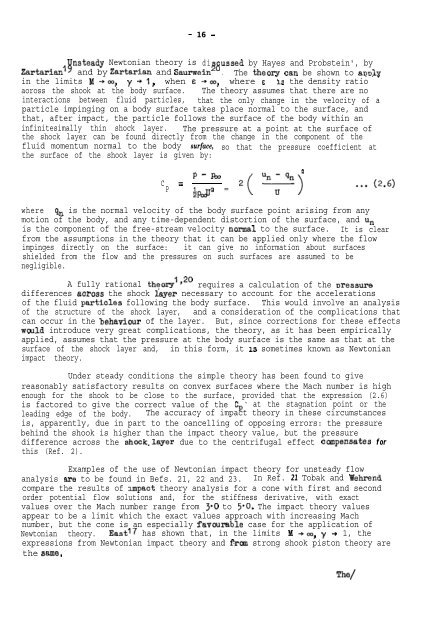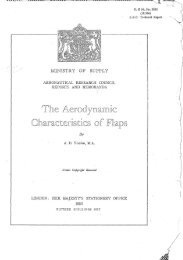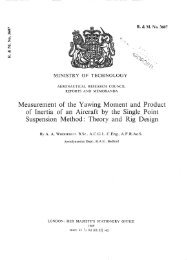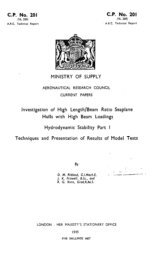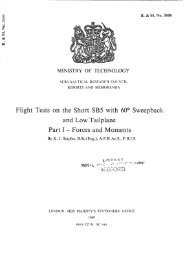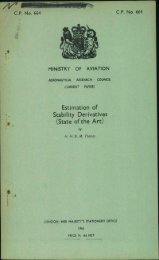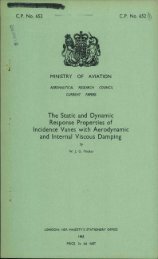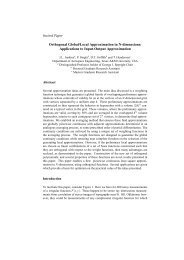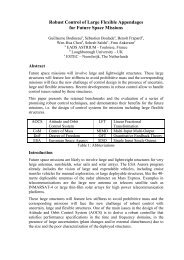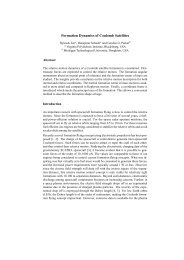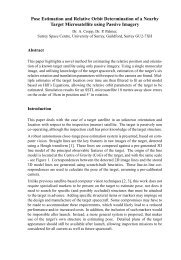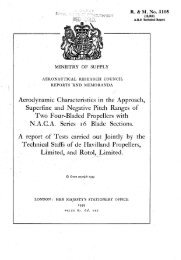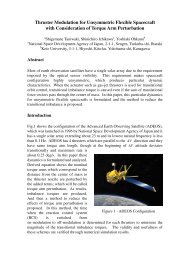A Survey of Unsteady Hypersonic Flow Problems
A Survey of Unsteady Hypersonic Flow Problems
A Survey of Unsteady Hypersonic Flow Problems
You also want an ePaper? Increase the reach of your titles
YUMPU automatically turns print PDFs into web optimized ePapers that Google loves.
- 16 -<br />
nsteady Newtonian theory is di ussed by Hayes and Probstein', by<br />
and by Zsrtarian and Saurwein 3s . The theorv can be shown to anulv . . "<br />
in the limits M +m, Y +I, when E +t, where E<br />
:<br />
is the density ratio<br />
aoross the shook at the body surface. The theory assumes that there are no<br />
interactions between fluid particles, that the only change in the velocity <strong>of</strong> a<br />
particle impinging on a body surface takes place normal to the surface, and<br />
that, after impact, the particle follows the surface <strong>of</strong> the body within an<br />
infinitesimally thin shock layer. The pressure at a point at the surface <strong>of</strong><br />
the shock layer can be found directly from the change in the component <strong>of</strong> the<br />
fluid momentum normal to the body surface, so that the pressure coefficient at<br />
the surface <strong>of</strong> the shook layer is given by:<br />
P-&Z<br />
C e<br />
P &@" = 2( "yqn]<br />
where qn is the normal velocity <strong>of</strong> the body surface point arising from any<br />
motion <strong>of</strong> the body, and any time-dependent distortion <strong>of</strong> the surface, and u,<br />
is the component <strong>of</strong> the free-stream velocity normal to the surface. It is clear<br />
from the assumptions in the theory that it can be applied only where the flow<br />
impinges directly on the surface: it can give no information about surfaces<br />
shielded from the flow and the pressures on such surfaces are assumed to be<br />
negligible.<br />
A fully rational theory'920 requires a calculation <strong>of</strong> the nressure<br />
differences aoross the shock iayer necessary to account for the accelerations<br />
<strong>of</strong> the fluid partioles following the body surface. This would involve an analysis<br />
<strong>of</strong> the structure <strong>of</strong> the shock layer, and a consideration <strong>of</strong> the complications that<br />
can occur in the behaviour <strong>of</strong> the layer. But, since corrections for these effects<br />
wolld introduce very great complications, the theory, as it has been empirically<br />
applied, assumes that the pressure at the body surface is the same as that at the<br />
surface <strong>of</strong> the shock layer and, in this form, it is sometimes known as Newtonian<br />
impact theory.<br />
Under steady conditions the simple theory has been found to give<br />
reasonably satisfactory results on convex surfaces where the Mach number is high<br />
enough for the shook to be close to the surface, provided that the expression (2.6)<br />
is factored to give the correct value <strong>of</strong> the Cp‘ at the stagnation point or the<br />
leading edge <strong>of</strong> the body. The accuracy <strong>of</strong> impact theory in these circumstances<br />
is, apparently, due in part to the oancelling <strong>of</strong> opposing errors: the pressure<br />
behind the shook is higher than the impact theory value, but the pressure<br />
difference across the shock.layer due to the centrifugal effect compensates for<br />
this (Ref. 2).<br />
Examples <strong>of</strong> the use <strong>of</strong> Newtonian impact theory for unsteady flow<br />
analysis are to be found in Befs. 21, 22 and 23. In Ref. 21 Tobak and Wehrend<br />
compare the results <strong>of</strong> impact theory analysis for a cone with first and second<br />
order potential flow solutions and, for the stiffness derivative, with exact<br />
values over the Mach number range from 3-O to 5-O. The impact theory values<br />
appear to be a limit which the exact values approach with increasing Mach<br />
number, but the cone is an especially favourable case for the application <strong>of</strong><br />
Newtonian theory. East'7 has shown that, in the limits M +co, y + 1, the<br />
expressions from Newtonian impact theory and f-ran strong shook piston theory are<br />
the same.


